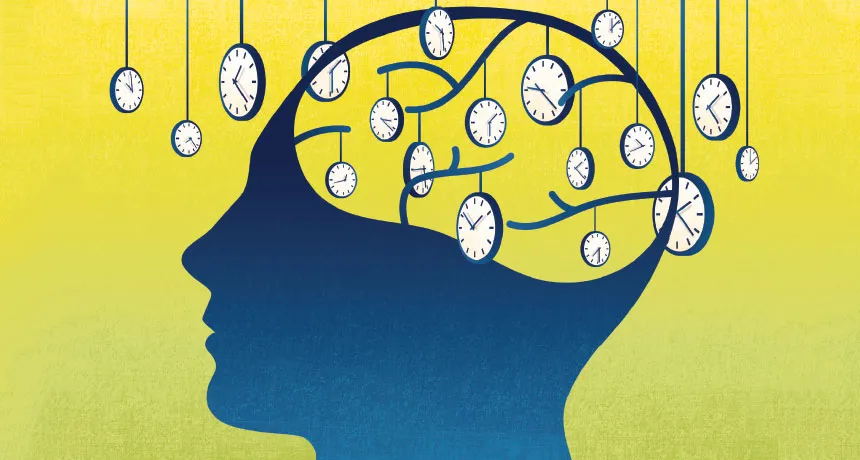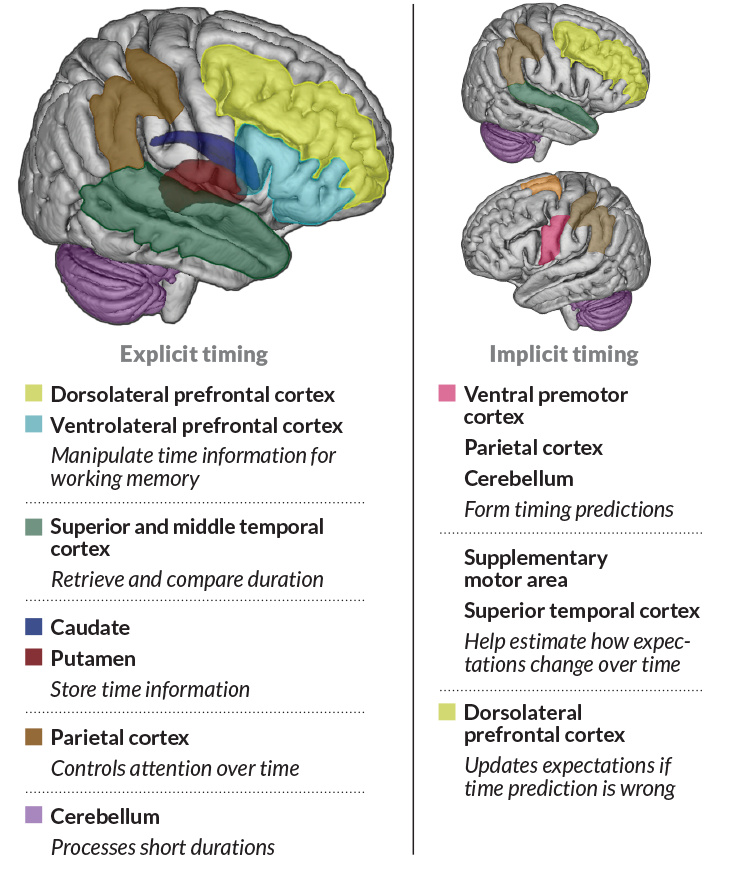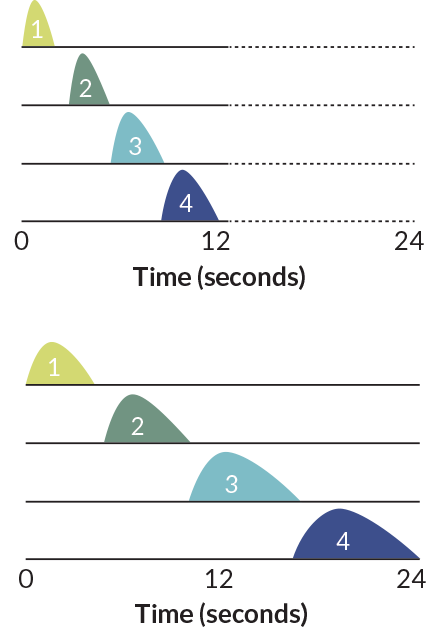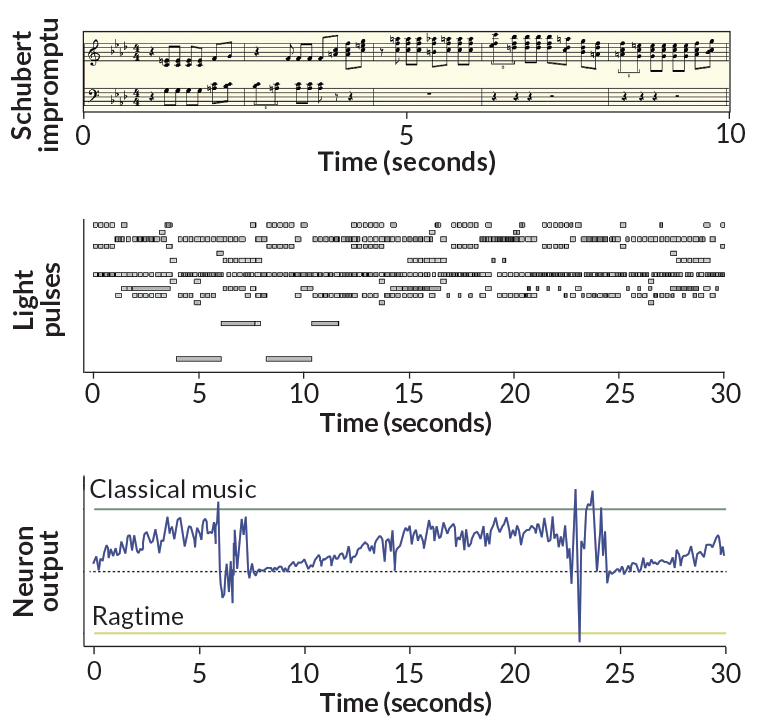How the brain perceives time
New experiments explore how the timekeepers in our heads help us make sense of the world

CLOCKING IN To perceive time, the brain relies on internal clocks that precisely orchestrate movement, sensing, memories and learning.
Tang Yau Hoong
Everybody knows people who seem to bumble through life with no sense of time — they dither for hours on a “quick” e-mail or expect an hour’s drive to take 20 minutes. These people are always late. But even for them, such minor lapses in timing are actually exceptions. We notice these flaws precisely because they’re out of the ordinary.
Humans, like other animals, are quite good at keeping track of passing time. This talent does more than keep office meetings running smoothly. Almost everything our bodies and brains do requires precision clockwork — down to milliseconds. Without a sharp sense of time, people would be reduced to insensate messes, unable to move, talk, remember or learn.
“We don’t think about it, but just walking down the street is an exquisitely timed operation,” says neuroscientist Lila Davachi of New York University. Muscles fire and joints steady themselves in a precisely orchestrated time series that masquerades as an unremarkable part of everyday life. A sense of time, Davachi says, is fundamental to how we move, how we act and how we perceive the world.
Yet for something that forms the bedrock of nearly everything we do, time perception is incredibly hard to study. “It’s a quagmire,” says cognitive neuroscientist Peter Tse of Dartmouth College.
The problem is thorny because there are thousands of possible intricate answers, all depending on what exactly scientists are asking. Their questions have begun to reveal an astonishingly complex conglomerate of neural timekeepers that influence each other.
New findings hint that the brain has legions of assorted clocks, all tick-tocking at different rates. Some parts of the brain handle milliseconds and others keep track of decades. Some neural timers handle body movements; others monitor information streaming in from the senses. Some brain departments make timing predictions for the future, while timing of memories is handled elsewhere.
This diversity has led some scientists to focus on figuring out how the brain stitches together the results from its many clocks to reflect the outside world accurately. A deeper understanding of how the brain’s timekeepers work might also shed light on something much more profound: how the brain constructs its own reality. The brain sometimes squishes, expands or warps time, some studies suggest. Subtle timing slips have been linked to emotions, attention, drugs and disorders such as schizophrenia. Those tweaks hint at how the brain normally counts seconds and milliseconds.
Time warp
To the chagrin of people looking for simple solutions, there is no tiny clock tucked beneath the skull that marks the passing seconds, Tse says. And the brain’s timekeeping is not always as reliable as the steady tapping of a metronome. Instead, time can sometimes be experienced as stretched out lulls followed by torrential bursts.
Most people have experienced this phenomenon firsthand. High-octane experiences can slow perception of time, flinging the world into slow motion. An out-of-control car careening toward the median or a skydiver’s plummet toward the ground can cause time to apparently stretch, making the event seem longer than it actually was.
Time can be stretched even without risking life and limb. After just 10 minutes of meditation, people seem to perceive time as lasting longer than it objectively does, scientists reported in 2013. Emotions can also stretch or contract time. Looking at angry faces or scary spiders makes people think that time slowed, for instance. To further muddle matters, simply knowing that this link between emotion and time perception exists can weaken the connection, French scientists reported April 15 in Consciousness and Cognition.
Even something as simple as temperature can change time perception. Walking on a treadmill in a hot room for an hour seemed to make time speed up for men in one study. After an hour, participants clicked a computer mouse after 2.6 seconds when they were supposed to click it at three-second intervals, an effect that wasn’t present when they were kept comfortably cool. After acclimating to the heat over a 10-day period, the men no longer misjudged time, scientists reported in the March International Journal of Psychophysiology. The results fit with older data suggesting that fevers can distort the perception of time.
Hallucinogenic mushrooms and drugs such as cocaine and LSD skew the brain’s sense of time, as can certain disorders. Children with attention-deficit/hyperactivity disorder have trouble telling apart two lengths of time. Parkinson’s disease can leave people with problems in timing seconds and subseconds. And even before symptoms appear, people with Huntington’s disease have deficits in estimating passing time.
Brain injuries can also warp a person’s sense of time, though such effects are almost always subtle — too subtle for patients to even notice, says cognitive neuroscientist Federica Piras of IRCCS Santa Lucia Foundation in Italy.
The fact that so many diverse diseases, injuries, drugs and even bodily states can sway time perception serves as powerful evidence that timekeeping in the brain is not a monolithic entity. Instead, people rely on a diverse collection of clocks, each with a different job description.
Neurons keep a beat
Most, if not all, of the brain probably has the ability to sense and respond to time in some way, many researchers think. Time is baked into almost everything the brain does. Even in a dish, nerve cells, or neurons, can detect and respond to time information, scientists reported in March in the Journal of Neuroscience.
Nerve cells removed from a rat’s cortex, the brain’s outer layer, will respond in complex ways to the tempo of music, neuroscientist Antonius VanDongen of Duke-NUS Graduate Medical School Singapore and colleagues have found. After genetically engineering a network of nerve cells to respond to blue light, the team regaled the cells with “music” — carefully timed patterns of light based on the rhythm and notes of songs. Upon “hearing” the songs, the cells’ electrical reactions could usually determine whether ragtime or classical music was playing at any given moment. And the cells got better as the seconds ticked by, hinting that they could hold a memory of the tempo information for about six seconds.
Those results show that time processing is fundamental in the brain, says VanDongen. “This is a very basic thing,” he says. A small group of neurons is the building block that may enable more sophisticated time processing.
Of course, nerve cells don’t usually live in lab dishes. The cells are housed in complex and diverse networks in the brain. Studies from human brain scans have also revealed clues about how the brain handles various aspects of time, suggesting roles for the cerebral cortex, the basal ganglia and the cerebellum. Activity in the insula (part of the cortex) changes when people are asked to estimate time by clicking a button at the end of an interval, for instance. And a recent study of people listening to snippets of foreign speech found a brain region, the superior temporal sulcus, that responds to increasingly longer sections of speech.
Neuroscientist Tobias Overath of Duke University and colleagues designed “sound quilts,” long strings of speech made by stitching together shorter chunks ranging from 30 to 960 milliseconds. The superior temporal sulcus became more active as the chunks of sound quilt grew longer, brain scans revealed. The findings serve as a good example of how the brain uses precise timing information as it merges disparate sounds into meaningful words. The results “are not overtly about time, or timing as such,” says Overath. “But it’s very compelling evidence of how time actually does play a role in something as important and fundamental to us humans as speech.”
It’s unclear what the individual neurons in the superior temporal sulcus are doing to track the lengthening sounds, Overath says. Brain scanning methods, like the fMRI used in the Duke study, don’t have the resolution required to detect the behavior of single nerve cells. But studies on animals may provide clues about how some neurons keep time.
A recent study in rats offers a clear explanation of how some cells tick off the seconds. Rats were trained to press a lever for a sip of water. But the water would appear only after a certain amount of time had elapsed. The rats quickly learned not to waste their energy pushing the lever when it was too early, a behavior that revealed their timing abilities.
While the rats were timing the appearance of the water, neuro-scientist Gustavo Mello of the Champalimaud Centre for the Unknown in Lisbon, Portugal, and colleagues eavesdropped with electrodes on neurons in the rats’ striatum, a brain area thought to be important for time perception. Sure enough, the team found cells that fired off electrical signals in a sequence that spanned the entire waiting period, the team reported in May in Current Biology. These cells were keeping track of the seconds that ticked by.
What’s more, many of the cells changed their behavior to remain in the right spot in their sequence even as the time intervals lengthened: A cell that always fired in the middle of a 12-second sequence would shift its behavior as the wait increased, firing around second 18 of a 36-second sequence, for instance.
Mello likens these cells to rubber bands that can expand and shrink to fill the necessary time. “You can stretch it and compress it,” he says. The results suggest that “the neurons are encoding relative time,” not absolute time, UCLA neuroscientists Helen Motanis and Dean Buonomano wrote in a Current Biology editorial.
The results are exciting, but Mello cautions that this example might not generalize to other timekeepers. “We should be very careful when making any statement about how the brain encodes or decodes time,” he says. “Encoding in what conditions? In what range?”
Rips in the fabric
Some of the brain’s clocks are known to keep time on different scales. For instance, the sound-processing system in the brain is much more precise when timing incoming signals than the visual system is, Overath says. That discrepancy between the senses is why CDs often include more than 44,000 segments of music per second, a number known as the sampling rate; videos often contain a mere 24 images per second. Yet the brain is still able to tie together those vastly different rates of information into an experience that makes sense, most of the time.
Even within the same system, the brain must actively manage timing signals. Imagine receiving simultaneous touches on the toe and on the nose, Tse says. It takes the toe touch tens of milliseconds longer to travel up the leg and body to reach the brain than the nose touch, yet you would perceive the two touches simultaneously. Your brain somehow knows to unite those two signals into a single event in time, even though they arrived at the brain separately.
The same sort of consolidation happens when watching TV. Although the sounds from the speakers don’t sync exactly with the signals from the screen, we don’t perceive a problem. Humans can tolerate about a fifth of a second of deviation between sight and sound before a bad dub becomes obvious.
The brain is able to knit different signals in time together into unifying experiences in what Tse calls a buffering process. Some type of a brain buffer collects data coming in over about a quarter of a second and stitches it together into discrete events that we recognize as “now.”
New work suggests that this process goes awry in people with schizophrenia, who often report time as a jumble. “It’s actually quite fascinating,” says neuroscientist Virginie van Wassenhove of INSERM in France. People with schizophrenia “describe their world as a movie that’s segmented and they have to reconstruct the meaning of that movie, because time is not continuous for them.”
When asked to make a conscious timing judgment, people with schizophrenia merge sights and sounds over a longer window of time than people without the disorder, according to research by van Wassenhove and her colleagues. Healthy people consciously combined sights and sound over a 200-millisecond window. For people with schizophrenia, that window stays open for around 300 or 400 milliseconds.
“In a way, a moment is consciously longer for them,” van Wassenhove says. This longer-than-usual “now” applied only to timing tasks when the study’s volunteers were explicitly asked to keep track of time, the researchers found. When not explicitly asked to pay attention to a timing task, healthy volunteers noticed timing discrepancies just as often as did people without schizophrenia. For example, a badly dubbed movie would be just as bothersome for both groups.
Those puzzling results hint at some profound differences in the way people with schizophrenia might process time, van Wassenhove says. Perhaps different neural systems are responsible for keeping track of time consciously and unconsciously, and those systems are affected differently by the disorder.
So far, scientists are struggling to make sense of these sorts of hints. But experiments are becoming more sophisticated as scientists attempt to mimic real-world scenarios. “In the real world, we don’t have tunnel vision,” says Warren Meck of Duke. “We’re not timing just one thing at a time and ignoring other things.” He and his colleagues are working on how brains keep track of multiple, simultaneous events. And new techniques to manipulate neurons will allow researchers to see if they can mimic time perception in the brain.
Other researchers are exploring concepts like musical rhythm, ordering events in time, and mental time travel, in which people imagine the past and the future. “All of these aspects are possible ways of approaching the big concept of time,” van Wassenhove says. Scientists hope that these types of experiments will ultimately reveal how the brain makes and keeps its own time.
This story appears in the July 25, 2015 issue with the headline, “Clocking in: The brain has a throng of timekeepers that stitch together a coherent reality.”










